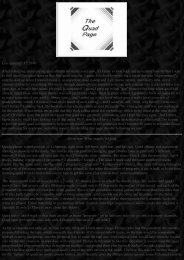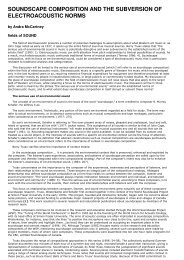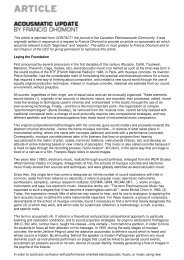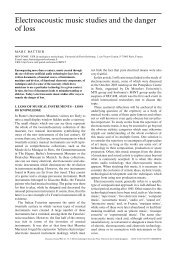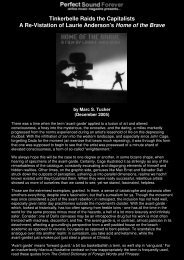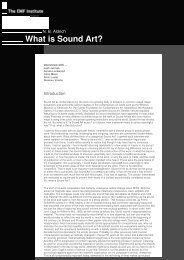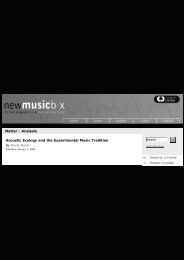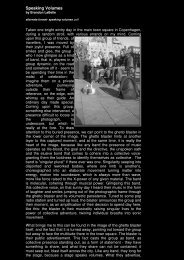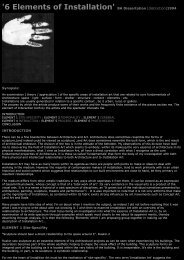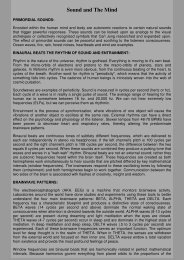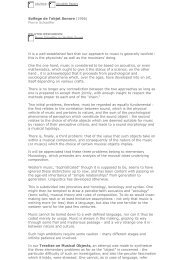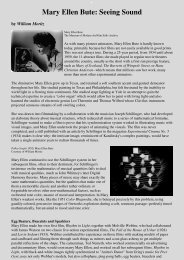Morgan-1994-A New Musical Reality- Futurism, Modernism and The ...
Morgan-1994-A New Musical Reality- Futurism, Modernism and The ...
Morgan-1994-A New Musical Reality- Futurism, Modernism and The ...
You also want an ePaper? Increase the reach of your titles
YUMPU automatically turns print PDFs into web optimized ePapers that Google loves.
the attributes of immateriality <strong>and</strong> flux when he described his reactions toWagner's music: "I imagined the idea of a soul moving in a luminousenvironment, of an ecstasy of voluptuousness <strong>and</strong> knowledge, floatingabove <strong>and</strong> beyond the natural world." 25Nineteenth-century composers, responding to such notions of unrestrictedmovement, began to feel hampered by the more solid, articulated musicalforms inherited from the previous century. Such forms treated music"spatially," carving it up into well-defined units joined together in cohesive,architectonic groups. Composers accordingly began to rethink musicalstructure in terms better suited to an image of reality as flux. Forms becamemore ambiguous, more unstable, in a state of permanent development--anidea quite foreign to eighteenth-century composers, for whom stability <strong>and</strong>instability were joined in an unmistakable, if delicate, balance. Wagnerperfectly expressed the tendency toward fluidity when he described hismusic as "an art of transition." 26 And the idea is still fully alive in Busoni'sremark in the <strong>New</strong> Aesthetic: "all composers have drawn nearest the truenature of music in preparatory <strong>and</strong> intermediary passages (preludes <strong>and</strong>transitions)." 27I have discussed elsewhere how the Romantic idea of music as a languageof pure form <strong>and</strong> motion encouraged nineteenth-century composers toundermine the conventional tonal syntax inherited from the eighteenthcentury. 28 If music was to be truly free, it had to unburden itself of theconstraints imposed by received conventions. <strong>The</strong> collapse of traditionaltonality, so closely allied with modernism, evident in both the "neotonal"leanings of Debussy, Stravinsky, <strong>and</strong> Bartók <strong>and</strong> the atonal ones ofSchoenberg, was the seemingly inevitable consequence of the Romanticidea of music's autonomy, of an art sheltered from all worldly involvement,including ultimately even a shared--<strong>and</strong> thus socially constituted--musicallanguage.<strong>The</strong> aesthetic orientation fostering music's preeminence had importantconsequences for the other arts. In literature it encouraged efforts to purgewords of their ordinary meanings, often to the extent of conferring uponthem a purely sonic value devoid of literal references, an idea that foundtypically drastic expression in Marinetti's parole in libertà, his "words setfree" from syntax, punctuation, linear placement on the page, "stupidformulas," <strong>and</strong> "the logical canal of syntax." This "unchained lyricism"would--<strong>and</strong> here one hears distinct echoes from the aesthetics of musicalromanticism--"bring us to the essence of material." 29<strong>The</strong> influence of the aesthetics of autonomous music is perhaps most clearlyrecognizable in the visual arts, especially in painting's break with objectiverepresentation as it approached pure abstraction around 1912. <strong>The</strong>"language" of nineteenth-century painting was--like that of music (butunlike literature)--an artificial one; <strong>and</strong> it too was tied to "syntactical"conventions, in this case those of perspectival representation. Hence the



